Weekly Mapping of Sea Ice Freeboard in the Ross Sea from ICESat-2
Abstract
1. Introduction
2. Study Area
3. Data
4. Methods
4.1. Subsampling of ATL10 Product to 3 km
4.2. Geostatistical Modeling
5. Results
5.1. Cross Validation of Kriging Estimated Freeboards
5.2. Variations of Variogram Factors
5.3. Weekly Freeboard Changes over the Ross Sea
5.3.1. Freeboard Changes from April to June (Slow-Freezing Season)
5.3.2. Freeboard Changes from July to September (Fast-Freezing Season)
5.3.3. Freeboard Changes from October to November (Melting Season)
6. Discussion
6.1. Comparison with NIC Ice Chart
6.2. Limitations of the Geostatistical Approach
7. Summary and Conclusions
Author Contributions
Funding
Acknowledgments
Conflicts of Interest
References
- Kurtz, N.T.; Markus, T. Satellite observations of Antarctic sea ice thickness and volume. J. Geophys. Res. Oceans 2012, 117, 1–9. [Google Scholar] [CrossRef]
- Allison, I.; Brandt, R.E.; Warren, S.G. East Antarctic sea ice: Albedo, thickness distribution, and snow cover. J. Geophys. Res. Oceans 1993, 98, 12417–12429. [Google Scholar] [CrossRef]
- Massom, R.A.; Eicken, H.; Hass, C.; Jeffries, M.O.; Drinkwater, M.R.; Sturm, M.; Worby, A.P.; Wu, X.; Lytle, V.I.; Ushio, S.; et al. Snow on Antarctic sea ice. Rev. Geophys. 2001, 39, 413–445. [Google Scholar] [CrossRef]
- Screen, J.A.; Simmonds, I. The central role of diminishing sea ice in recent Arctic temperature amplification. Nature 2010, 464, 1334–1337. [Google Scholar] [CrossRef]
- Brandt, R.E.; Warren, S.G.; Worby, A.P.; Grenfell, T.C. Surface Albedo of the Antarctic Sea Ice Zone. J. Clim. 2005, 18, 3606–3622. [Google Scholar] [CrossRef]
- Serreze, M.C.; Barry, R.G. Processes and impacts of Arctic amplification: A research synthesis. Glob. Planet. Chang. 2011, 77, 85–96. [Google Scholar] [CrossRef]
- Gordon, A.L. Two Stable Modes of Southern Ocean Winter Stratification. In Deep Convection and Deep Water Formation in the Oceans; Chu, P.C., Gascard, J.C., Eds.; Elsevier Oceanography Series; Elsevier: Amsterdam, The Netherlands, 1991; Volume 57, pp. 17–35. [Google Scholar]
- Cavalieri, D.J.; Parkinson, C.L. Large-Scale Variations in Observed Antarctic Sea Ice Extent and Associated Atmospheric Circulation. Mon. Weather Rev. 1981, 109, 2323–2336. [Google Scholar] [CrossRef]
- Comiso, J.C.; Gersten, R.A.; Stock, L.V.; Turner, J.; Perez, G.J.; Cho, K. Positive Trend in the Antarctic Sea Ice Cover and Associated Changes in Surface Temperature. J. Clim. 2017, 30, 2251–2267. [Google Scholar] [CrossRef] [PubMed]
- Garrison, D.L. Antarctic Sea Ice Biota. Am. Zool. 1991, 31, 17–33. [Google Scholar] [CrossRef]
- Legendre, L.; Ackley, S.F.; Dieckmann, G.S.; Gulliksen, B.; Horner, R.; Hoshiai, T.; Melnikov, I.A.; Reeburgh, W.S.; Spindler, M.; Sullivan, C.W. Ecology of sea ice biota. Polar Biol. 1992, 12, 429–444. [Google Scholar] [CrossRef]
- Kwok, R.; Rothrock, D.A. Decline in Arctic sea ice thickness from submarine and ICESat records: 1958–2008. Geophys. Res. Lett. 2009, 36. [Google Scholar] [CrossRef]
- Simmonds, I. Comparing and contrasting the behaviour of Arctic and Antarctic sea ice over the 35 year period 1979–2013. Ann. Glaciol. 2015, 56, 18–28. [Google Scholar] [CrossRef]
- Comiso, J.C.; Parkinson, C.L.; Gersten, R.; Stock, L. Accelerated decline in the Arctic sea ice cover. Geophys. Res. Lett. 2008, 35. [Google Scholar] [CrossRef]
- Kurtz, N.T.; Markus, T.; Farrell, S.L.; Worthen, D.L.; Boisvert, L.N. Observations of recent Arctic sea ice volume loss and its impact on ocean-atmosphere energy exchange and ice production. J. Geophys. Res. Oceans 2011, 116. [Google Scholar] [CrossRef]
- Notz, D.; Stroeve, J. Observed Arctic sea-ice loss directly follows anthropogenic CO2 emission. Science 2016, 354, 747–750. [Google Scholar] [CrossRef] [PubMed]
- Parkinson, C.L. A 40-y record reveals gradual Antarctic sea ice increases followed by decreases at rates far exceeding the rates seen in the Arctic. Proc. Natl. Acad. Sci. USA 2019, 116, 14414–14423. [Google Scholar] [CrossRef]
- Ludescher, J.; Yuan, N.; Bunde, A. Detecting the statistical significance of the trends in the Antarctic sea ice extent: An indication for a turning point. Clim. Dyn. 2019, 53, 237–244. [Google Scholar] [CrossRef]
- Massonnet, F.; Mathiot, P.; Fichefet, T.; Goosse, H.; König Beatty, C.; Vancoppenolle, M.; Lavergne, T. A model reconstruction of the Antarctic sea ice thickness and volume changes over 1980–2008 using data assimilation. Ocean Model. 2013, 64, 67–75. [Google Scholar] [CrossRef]
- Holland, P.R.; Bruneau, N.; Enright, C.; Losch, M.; Kurtz, N.T.; Kwok, R. Modeled trends in antarctic sea ice thickness. J. Clim. 2014, 27, 3784–3801. [Google Scholar] [CrossRef]
- Parkinson, C.L.; Cavalieri, D.J. Antarctic sea ice variability and trends, 1979–2010. Cryosphere 2012, 6, 871–880. [Google Scholar] [CrossRef]
- Yuan, N.; Ding, M.; Ludescher, J.; Bunde, A. Increase of the Antarctic Sea Ice Extent is highly significant only in the Ross Sea. Sci. Rep. 2017, 7, 41096. [Google Scholar] [CrossRef] [PubMed]
- Tamura, T.; Ohshima, K.I.; Fraser, A.D.; Williams, G.D. Sea ice production variability in Antarctic coastal polynyas. J. Geophys. Res. Oceans 2016, 121, 2967–2979. [Google Scholar] [CrossRef]
- Tamura, T.; Ohshima, K.I.; Nihashi, S. Mapping of sea ice production for Antarctic coastal polynyas. Geophys. Res. Lett. 2008, 35. [Google Scholar] [CrossRef]
- Nihashi, S.; Ohshima, K.I.; Tamura, T. Sea-Ice Production in Antarctic Coastal Polynyas Estimated from AMSR2 Data and Its Validation Using AMSR-E and SSM/I-SSMIS Data. IEEE J. Sel. Top. Appl. Earth Obs. Remote Sens. 2017, 10, 3912. [Google Scholar] [CrossRef]
- Tian, L.; Xie, H.; Ackley, S.F.; Tang, J.; Mestas-Nuñez, A.M.; Wang, X. Sea-ice freeboard and thickness in the Ross Sea from airborne (IceBridge 2013) and satellite (ICESat 2003–2008) observations. Ann. Glaciol. 2020, 61, 24–39. [Google Scholar] [CrossRef]
- Dai, L.; Xie, H.; Ackley, S.F.; Mestas-Nuñez, A.M. Ice Production in Ross Ice Shelf Polynyas during 2017–2018 from Sentinel–1 SAR Images. Remote Sens. 2020, 12, 1484. [Google Scholar] [CrossRef]
- Li, H.; Xie, H.; Kern, S.; Wan, W.; Ozsoy, B.; Ackley, S.; Hong, Y. Spatio-temporal variability of Antarctic sea-ice thickness and volume obtained from ICESat data using an innovative algorithm. Remote Sens. Environ. 2018, 219, 44–61. [Google Scholar] [CrossRef]
- Drucker, R.; Martin, S.; Kwok, R. Sea ice production and export from coastal polynyas in the Weddell and Ross Seas. Geophys. Res. Lett. 2011, 38. [Google Scholar] [CrossRef]
- Tin, T.; Jeffries, M.O. Sea-ice thickness and roughness in the Ross Sea, Antartica. Ann. Glaciol. 2001, 33, 187–193. [Google Scholar] [CrossRef][Green Version]
- Markus, T.; Neumann, T.; Martino, A.; Abdalati, W.; Brunt, K.; Csatho, B.; Farrell, S.; Fricker, H.; Gardner, A.; Harding, D.; et al. The Ice, Cloud, and land Elevation Satellite-2 (ICESat-2): Science requirements, concept, and implementation. Remote Sens. Environ. 2017, 190, 260–273. [Google Scholar] [CrossRef]
- Magruder, L.A.; Brunt, K.M.; Alonzo, M. Early icesat-2 on-orbit geolocation validation using ground-based corner cube retro-reflectors. Remote Sens. 2020, 12, 3653. [Google Scholar] [CrossRef]
- Zwally, H.J.; Schutz, B.; Abdalati, W.; Abshire, J.; Bentley, C.; Brenner, A.; Bufton, J.; Dezio, J.; Hancock, D.; Harding, D.; et al. ICESat’s laser measurements of polar ice, atmosphere, ocean, and land. J. Geodyn. 2002, 34, 405–445. [Google Scholar] [CrossRef]
- Kacimi, S.; Kwok, R. The Antarctic sea ice cover from ICESat-2 and CryoSat-2: Freeboard, snow depth and ice thickness. Cryosph. Discuss. 2020, 14, 4453–4474. [Google Scholar] [CrossRef]
- Petty, A.A.; Kurtz, N.T.; Kwok, R.; Markus, T.; Neumann, T. Winter Arctic sea ice thickness from ICESat-2 freeboards. J. Geophys. Res. Oceans 2020, 125, e2019JC015764. [Google Scholar] [CrossRef]
- Kwok, R.; Kacimi, S.; Webster, M.A.; Kurtz, N.T.; Petty, A.A. Arctic Snow Depth and Sea Ice Thickness From ICESat-2 and CryoSat-2 Freeboards: A First Examination. J. Geophys. Res. Oceans 2020, 125, 1–19. [Google Scholar] [CrossRef]
- Kwok, R.; Markus, T.; Kurtz, N.T.; Petty, A.A.; Neumann, T.A.; Farrell, S.L.; Cunningham, G.F.; Hancock, D.W.; Ivanoff, A.; Wimert, J.T. Surface Height and Sea Ice Freeboard of the Arctic Ocean From ICESat-2: Characteristics and Early Results. J. Geophys. Res. Oceans 2019, 124, 6942–6959. [Google Scholar] [CrossRef]
- Bromwich, D.; Liu, Z.; Rogers, A.N.; Van Woert, M.L. Winter Atmospheric Forcing of the Ross Sea Polynya. Ocean Ice Atmos. Interact. Antarct. Continenal Margin 1998, 75, 101–133. [Google Scholar]
- Dale, E.R.; McDonald, A.J.; Coggins, J.H.J.; Rack, W. Atmospheric forcing of sea ice anomalies in the Ross Sea polynya region. Cryosphere 2017, 11, 267–280. [Google Scholar] [CrossRef]
- Kwok, R.; Comiso, J.C.; Martin, S.; Drucker, R. Ross Sea polynyas: Response of ice concentration retrievals to large areas of thin ice. J. Geophys. Res. Oceans 2007, 112. [Google Scholar] [CrossRef]
- Li, J.; Heap, A.D. A review of comparative studies of spatial interpolation methods in environmental sciences: Performance and impact factors. Ecol. Inform. 2011, 6, 228–241. [Google Scholar] [CrossRef]
- Chang, K.-T. Introduction to Geographic Information Systems, 8th ed.; McGraw-Hill Education: New York, NY, USA, 2016; ISBN 9780078095139. [Google Scholar]
- Krige, D.G. A statistical approach to some basic mine valuation problems on the Witwatersrand. J. Soc. Afr. Inst. Min. Metall. 1951, 52, 119–139. [Google Scholar]
- Herzfeld, U.C.; Maslanik, J.A.; Sturm, M. Geostatistical characterization of snow-depth structures on sea ice near Point Barrow, Alaska—A contribution to the AMSR-Ice03 field validation campaign. IEEE Trans. Geosci. Remote Sens. 2006, 44, 3038–3056. [Google Scholar] [CrossRef]
- Iacozza, J.; Barber, D.G. An examination of the distribution of snow on sea-ice. Atmos. Ocean 1999, 37, 21–51. [Google Scholar] [CrossRef]
- Huang, C.L.; Wang, H.W.; Hou, J.L. Estimating spatial distribution of daily snow depth with kriging methods: Combination of MODIS snow cover area data and ground-based observations. Cryosph. Discuss. 2015, 9, 4997–5020. [Google Scholar]
- Stosius, R.; Herzfeld, U.C. Geostatistical estimation from radar altimeter data with respect to morphological units outlined by SAR data: Application to Lambert Glacier/Amery Ice shelf, East Antarctica. Ann. Glaciol. 2004, 39, 251–255. [Google Scholar] [CrossRef]
- Griggs, J.A.; Bamber, J.L. Antarctic ice-shelf thickness from satellite radar altimetry. J. Glaciol. 2011, 57, 485–498. [Google Scholar] [CrossRef]
- Strößenreuther, U.; Horwath, M.; Schröder, L. How Different Analysis and Interpolation Methods Affect the Accuracy of Ice Surface Elevation Changes Inferred from Satellite Altimetry. Math. Geosci. 2020, 52, 499–525. [Google Scholar] [CrossRef]
- Hurkmans, R.T.W.L.; Bamber, J.L.; Srensen, L.S.; Joughin, I.R.; Davis, C.H.; Krabill, W.B. Spatiotemporal interpolation of elevation changes derived from satellite altimetry for Jakobshavn Isbr, Greenland. J. Geophys. Res. Earth Surf. 2012, 117, 1–16. [Google Scholar] [CrossRef]
- Hurkmans, R.T.W.L.; Bamber, J.L.; Davis, C.H.; Joughin, I.R.; Khvorostovsky, K.S.; Smith, B.S.; Schoen, N. Time-evolving mass loss of the Greenland Ice Sheet from satellite altimetry. Cryosphere 2014, 8, 1725–1740. [Google Scholar] [CrossRef]
- Lindsay, R.; Haas, C.; Hendricks, S.; Hunkeler, P.; Kurtz, N.; Paden, J.; Panzer, B.; Sonntag, J.; Yungel, J.; Zhang, J. Seasonal forecasts of Arctic sea ice initialized with observations of ice thickness. Geophys. Res. Lett. 2012, 39, 1–6. [Google Scholar] [CrossRef]
- Kurtz, N.T.; Farrell, S.L.; Studinger, M.; Galin, N.; Harbeck, J.P.; Lindsay, R.; Onana, V.D.; Panzer, B.; Sonntag, J.G. Sea ice thickness, freeboard, and snow depth products from Operation IceBridge airborne data. Cryosphere 2013, 7, 1035–1056. [Google Scholar] [CrossRef]
- Wang, Y.; Hou, S. A new interpolation method for Antarctic surface temperature. Prog. Nat. Sci. 2009, 19, 1843–1849. [Google Scholar] [CrossRef]
- Herzfeld, U.C.; Mayer, H.; Feller, W.; Mimler, M. Geostatistical analysis of glacier-roughness data. Ann. Glaciol. 2000, 30, 235–242. [Google Scholar] [CrossRef]
- Smith, S.D.; Muench, R.D.; Pease, C.H. Polynyas and leads: An overview of physical processes and environment. J. Geophys. Res. Oceans 1990, 95, 9461–9479. [Google Scholar] [CrossRef]
- Bromwich, D.H.; Carrasco, J.F.; Liu, Z.; Tzeng, R.-Y. Hemispheric atmospheric variations and oceanographic impacts associated with katabatic surges across the Ross ice shelf, Antarctica. J. Geophys. Res. Atmos. 1993, 98, 13045–13062. [Google Scholar] [CrossRef]
- Thompson, L.; Smith, M.; Thomson, J.; Stammerjohn, S.; Ackley, S.; Loose, B. Frazil ice growth and production during katabatic wind events in the Ross Sea, Antarctica. Cryosphere 2020, 14, 3329–3347. [Google Scholar] [CrossRef]
- Kwok, R.; Kacimi, S.; Markus, T.; Kurtz, N.T.; Studinger, M.; Sonntag, J.G.; Manizade, S.S.; Boisvert, L.N.; Harbeck, J.P. ICESat-2 Surface Height and Sea Ice Freeboard Assessed With ATM Lidar Acquisitions From Operation IceBridge. Geophys. Res. Lett. 2019, 46, 11228–11236. [Google Scholar] [CrossRef]
- Kwok, R.; Cunningham, G.; Hancock, D.; Ivanoff, A.; Wimert, J. Algorithm Theoretical Basis Document (ATBD): Sea Ice Products; NASA Goddard Space Flight Center: Greenbelt, MD, USA, 2019. [Google Scholar]
- Abzalov, M. Introduction to Geostatistics. In Applied Mining Geology; Springer International Publishing: Cham, Switzerland, 2016; pp. 233–237. ISBN 978-3-319-39264-6. [Google Scholar]
- Landy, J.C.; Petty, A.A.; Tsamados, M.; Stroeve, J.C. Sea ice roughness overlooked as a key source of uncertainty in CryoSat-2 ice freeboard retrievals. J. Geophys. Res. Oceans 2020, 125, e2019JC015820. [Google Scholar] [CrossRef]
- Farrell, S.L.; Kurtz, N.; Connor, L.N.; Elder, B.C.; Leuschen, C.; Markus, T.; McAdoo, D.C.; Panzer, B.; Richter-Menge, J.; Sonntag, J.G. A first assessment of IceBridge Snow and Ice thickness data over arctic sea ice. IEEE Trans. Geosci. Remote Sens. 2012, 50, 2098–2111. [Google Scholar] [CrossRef]
- Hansen, E.; Gerland, S.; Granskog, M.A.; Pavlova, O.; Renner, A.H.H.; Haapala, J.; Løyning, T.B.; Tschudi, M. Thinning of Arctic sea ice observed in Fram Strait: 1990–2011. J. Geophys. Res. Oceans 2013, 118, 5202–5221. [Google Scholar] [CrossRef]
- Kwok, R.; Cunningham, G.F.; Kacimi, S.; Webster, M.A.; Kurtz, N.T.; Petty, A.A. Decay of the Snow Cover Over Arctic Sea Ice From ICESat-2 Acquisitions During Summer Melt in 2019. Geophys. Res. Lett. 2020, 47, 1–10. [Google Scholar] [CrossRef]
- Schober, P.; Schwarte, L.A. Correlation coefficients: Appropriate use and interpretation. Anesth. Analg. 2018, 126, 1763–1768. [Google Scholar] [CrossRef] [PubMed]
- Rack, W.; Price, D.; Haas, C.; Langhorne, P.J.; Leonard, G.H. Sea Ice Thickness in the Western Ross Sea. Geophys. Res. Lett. 2020, 48, e2020GL090866. [Google Scholar]
- Kwok, R.; Pang, S.S.; Kacimi, S. Sea ice drift in the Southern Ocean: Regional patterns, variability, and trends. Elem. Sci. Anthr. 2017, 5, 32. [Google Scholar] [CrossRef]
- DeLiberty, T.L.; Geiger, C.A.; Ackley, S.F.; Worby, A.P.; Van Woert, M.L. Estimating the annual cycle of sea-ice thickness and volume in the Ross Sea. Deep Sea Res. Part II Top. Stud. Oceanogr. 2011, 58, 1250–1260. [Google Scholar] [CrossRef]
- Worby, A.P.; Geiger, C.A.; Paget, M.J.; Van Woert, M.L.; Ackley, S.F.; DeLiberty, T.L. Thickness distribution of Antarctic sea ice. J. Geophys. Res. Oceans 2008, 113, 1–14. [Google Scholar] [CrossRef]
- Kwok, R. Ross sea ice motion, area flux, and deformation. J. Clim. 2005, 18, 3759–3776. [Google Scholar] [CrossRef]
- U.S. National Ice Center. National Ice Center Arctic Sea Ice Charts and Climatologies in Gridded Format; U.S. National Ice Center: Suitland, MD, USA, 2006; p. 41. [Google Scholar]
- Ozsoy-Cicek, B.; Ackley, S.; Xie, H.; Yi, D.; Zwally, J. Sea ice thickness retrieval algorithms based on in situ surface elevation and thickness values for application to altimetry. J. Geophys. Res. Oceans 2013, 118, 3807–3822. [Google Scholar] [CrossRef]
- Ackley, S.F.; Stammerjohn, S.; Maksym, T.; Smith, M.; Cassano, J.; Guest, P.; Tison, J.L.; Delille, B.; Loose, B.; Sedwick, P.; et al. Sea-ice production and air/ice/ocean/biogeochemistry interactions in the Ross Sea during the PIPERS 2017 autumn field campaign. Ann. Glaciol. 2020, 61, 181–195. [Google Scholar] [CrossRef]
- Webster, R.; Oliver, M.A. How Large a Sample Is Needed to Estimate the Regional Variogram Adequately? BT—Geostatistics Tróia ’92: Volume 1; Soares, A., Ed.; Springer: Dordrecht, The Netherlands, 1993; pp. 155–166. ISBN 978-94-011-1739-5. [Google Scholar]
- Webster, R.; Oliver, M.A. Sample adequately to estimate variograms of soil properties. J. Soil Sci. 1992, 43, 177–192. [Google Scholar] [CrossRef]

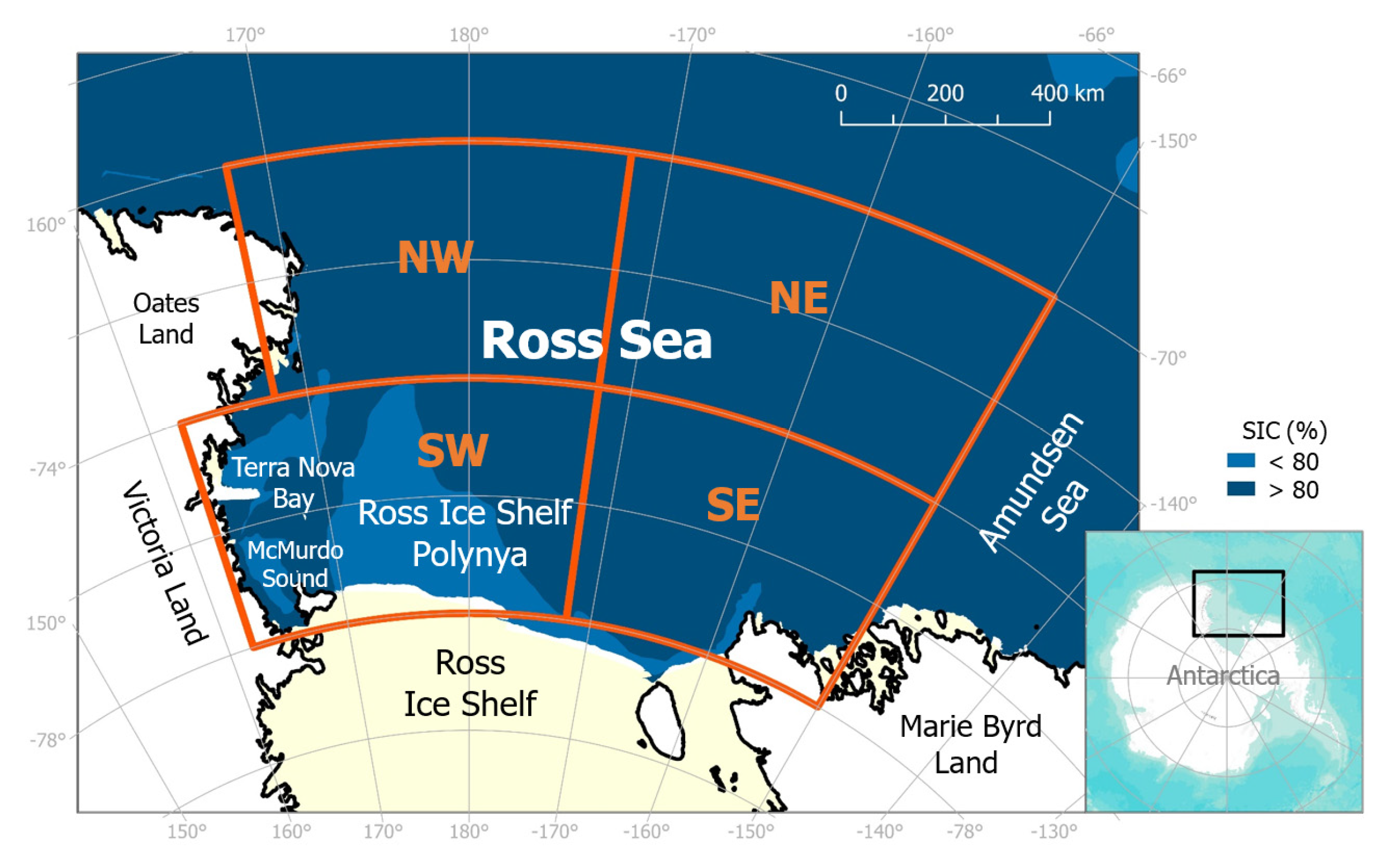
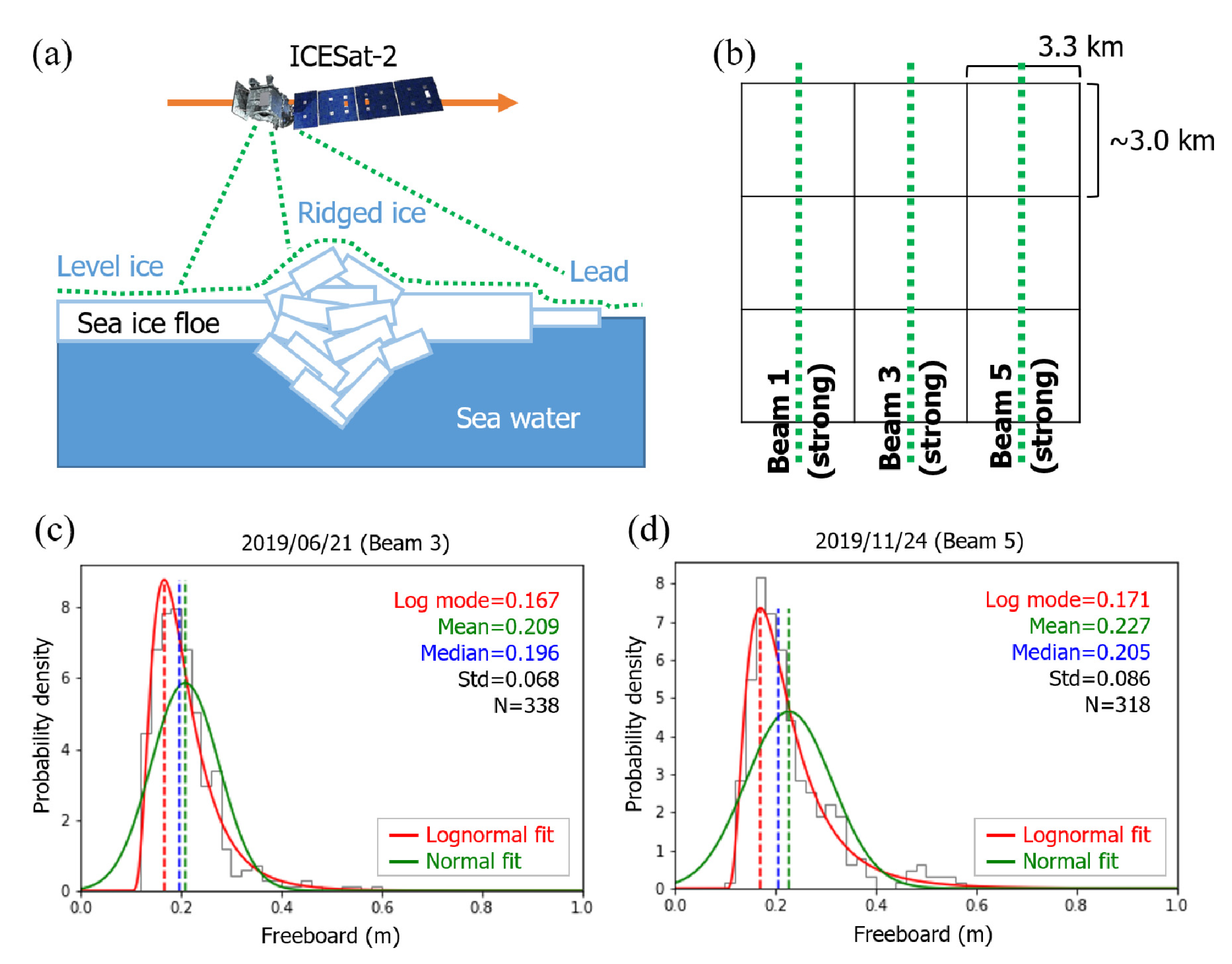
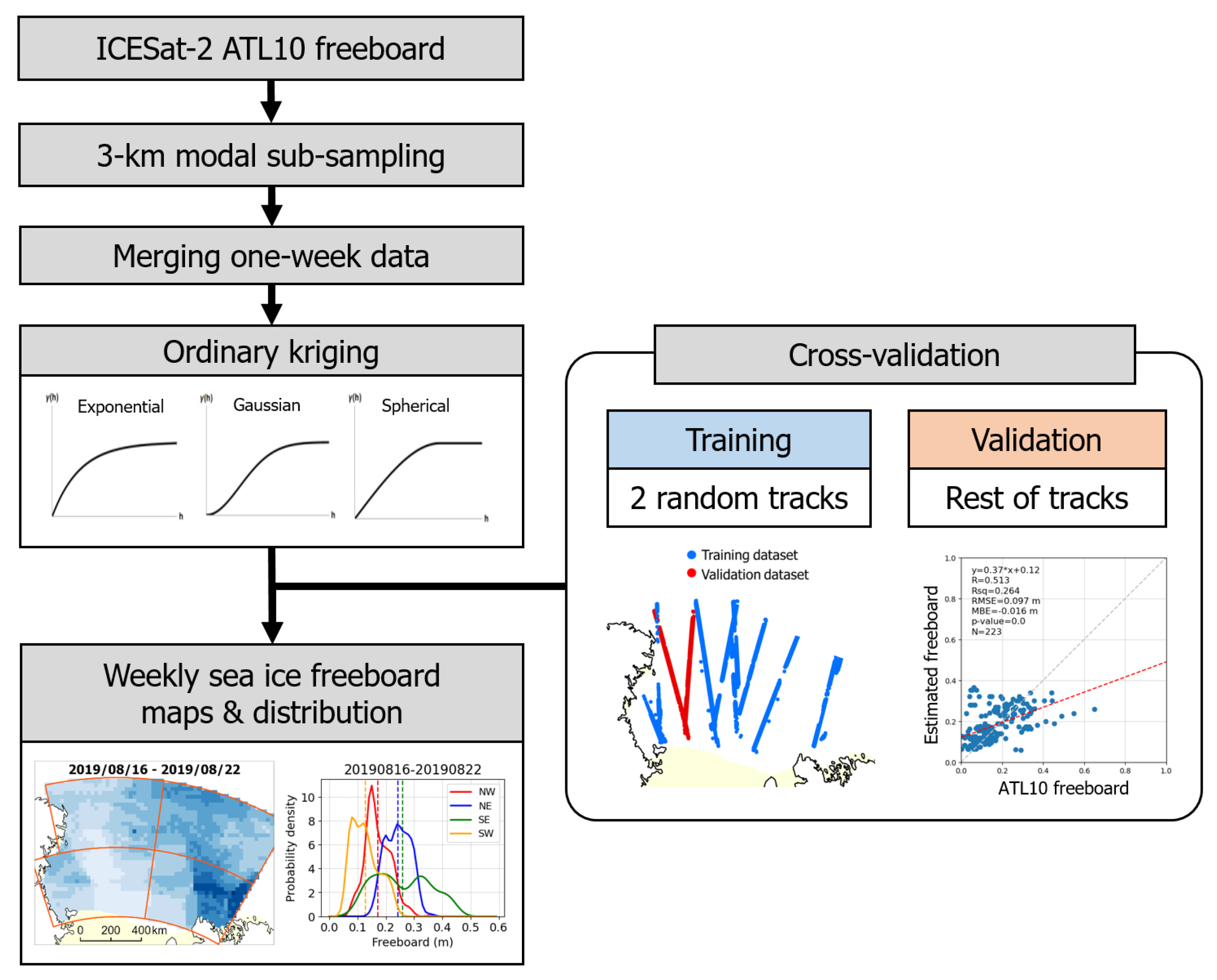

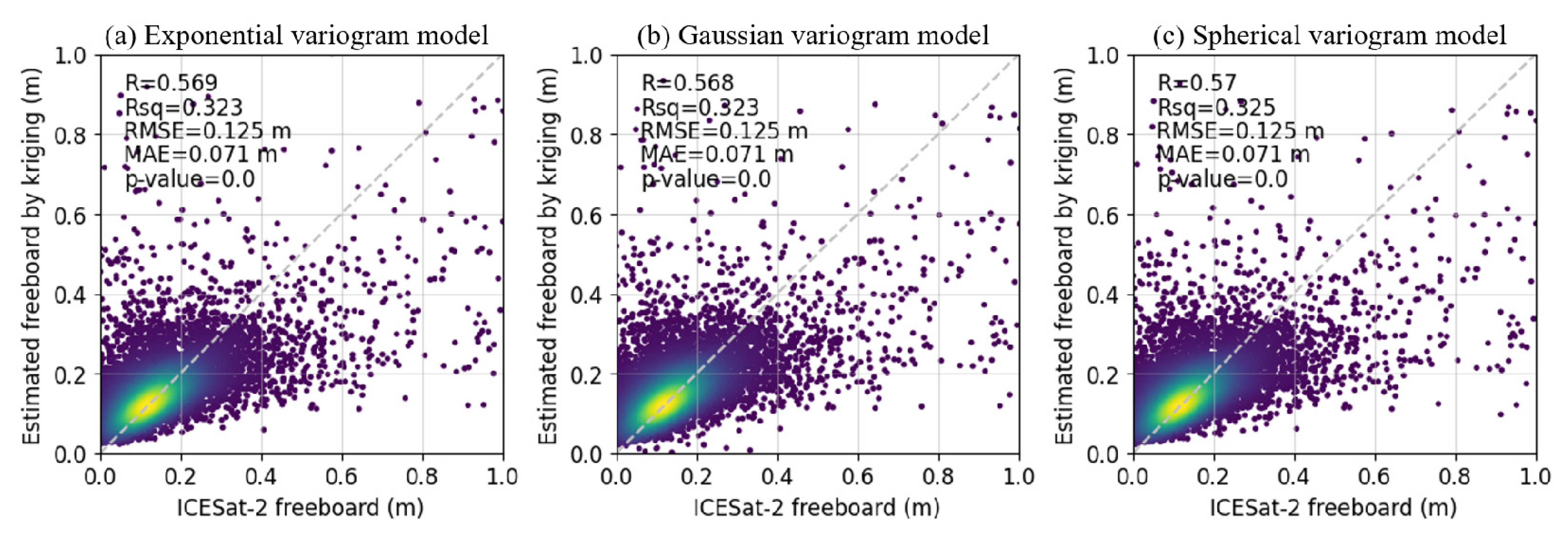
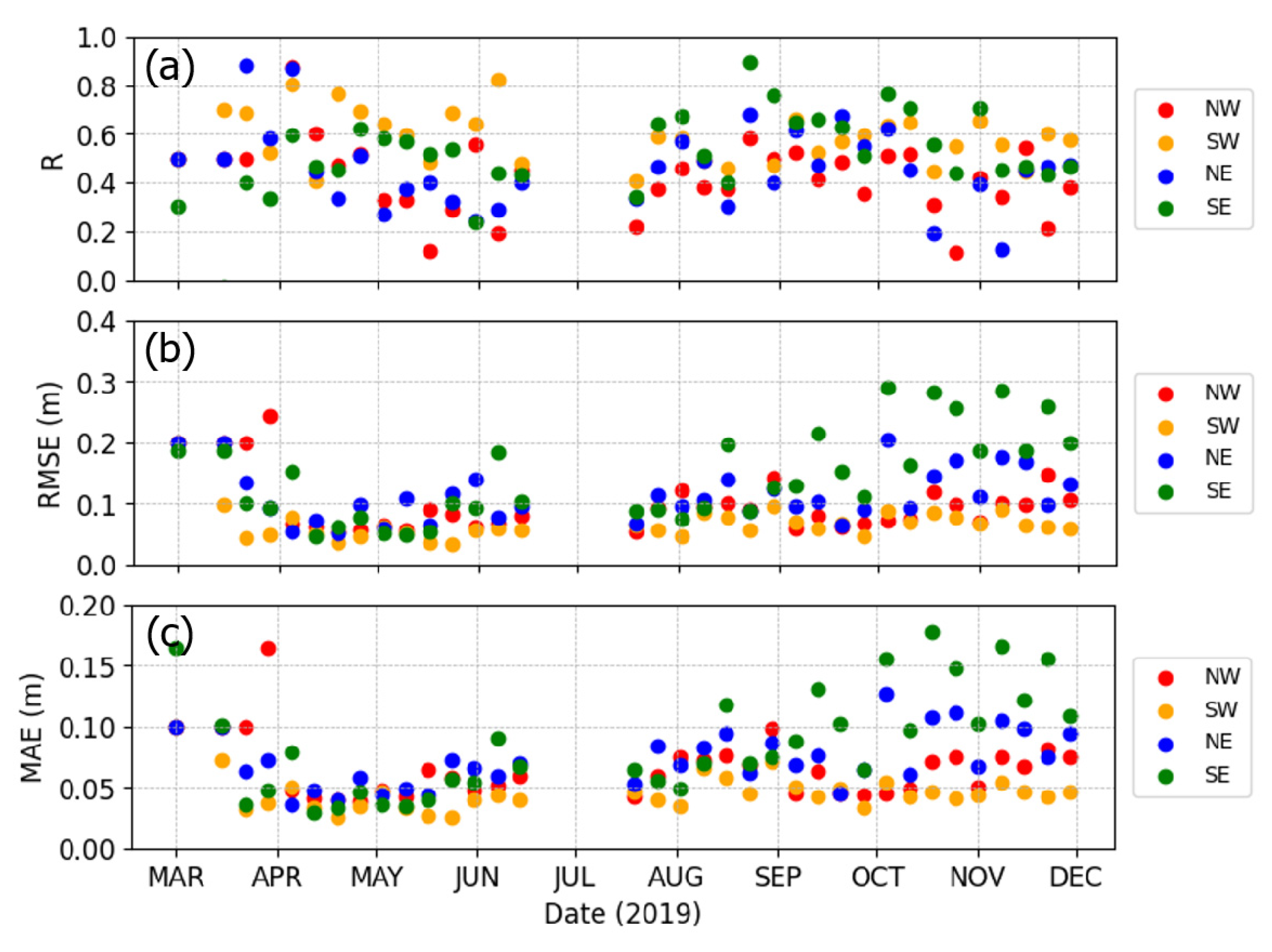


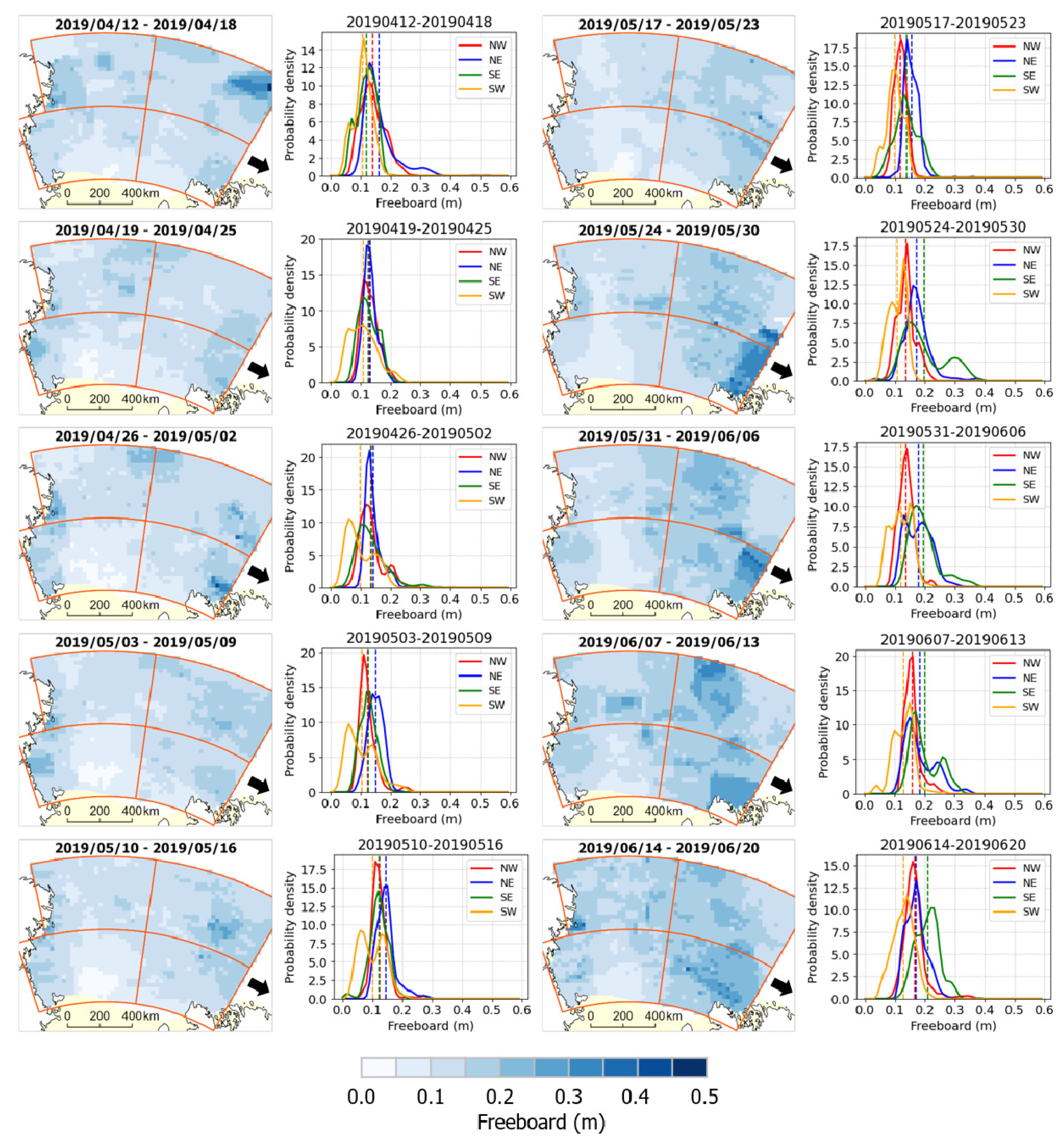
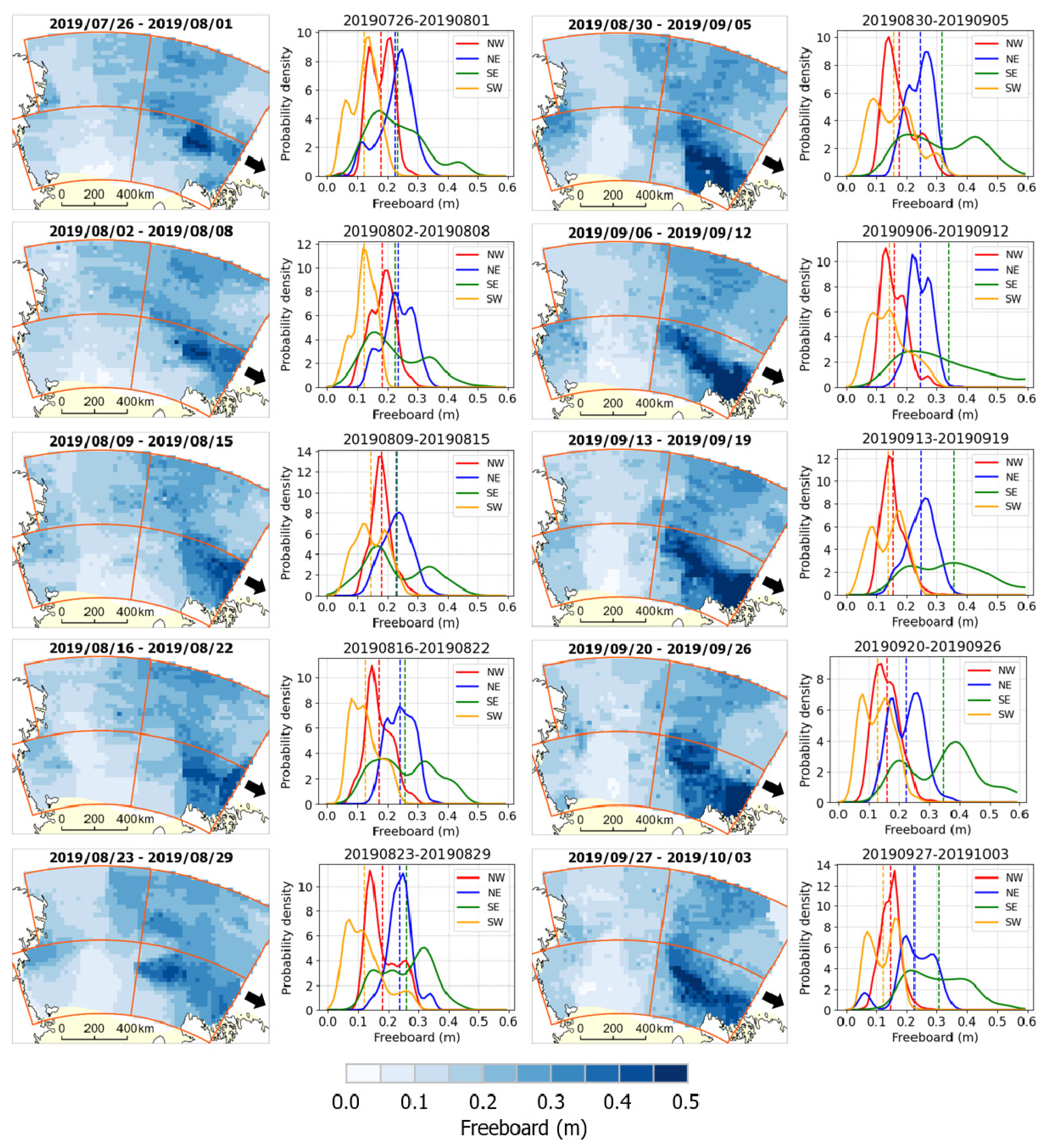


Publisher’s Note: MDPI stays neutral with regard to jurisdictional claims in published maps and institutional affiliations. |
© 2021 by the authors. Licensee MDPI, Basel, Switzerland. This article is an open access article distributed under the terms and conditions of the Creative Commons Attribution (CC BY) license (https://creativecommons.org/licenses/by/4.0/).
Share and Cite
Koo, Y.; Xie, H.; Kurtz, N.T.; Ackley, S.F.; Mestas-Nuñez, A.M. Weekly Mapping of Sea Ice Freeboard in the Ross Sea from ICESat-2. Remote Sens. 2021, 13, 3277. https://doi.org/10.3390/rs13163277
Koo Y, Xie H, Kurtz NT, Ackley SF, Mestas-Nuñez AM. Weekly Mapping of Sea Ice Freeboard in the Ross Sea from ICESat-2. Remote Sensing. 2021; 13(16):3277. https://doi.org/10.3390/rs13163277
Chicago/Turabian StyleKoo, YoungHyun, Hongjie Xie, Nathan T. Kurtz, Stephen F. Ackley, and Alberto M. Mestas-Nuñez. 2021. "Weekly Mapping of Sea Ice Freeboard in the Ross Sea from ICESat-2" Remote Sensing 13, no. 16: 3277. https://doi.org/10.3390/rs13163277
APA StyleKoo, Y., Xie, H., Kurtz, N. T., Ackley, S. F., & Mestas-Nuñez, A. M. (2021). Weekly Mapping of Sea Ice Freeboard in the Ross Sea from ICESat-2. Remote Sensing, 13(16), 3277. https://doi.org/10.3390/rs13163277






